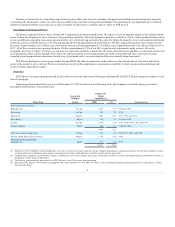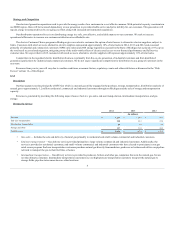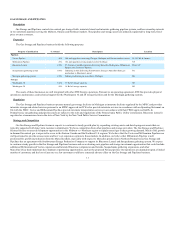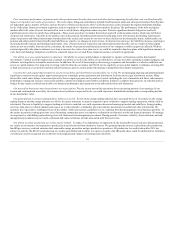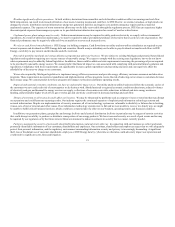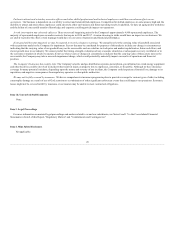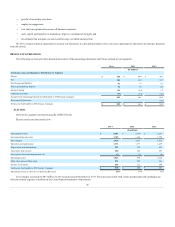DTE Energy 2014 Annual Report Download - page 18
Download and view the complete annual report
Please find page 18 of the 2014 DTE Energy annual report below. You can navigate through the pages in the report by either clicking on the pages listed below, or by using the keyword search tool below to find specific information within the annual report.
In December 2014, the EPA released a pre-publication version of a rule to regulate coal ash. This rule is based on the continued listing of ash as a non-
hazardous waste, and relies on various self-implementation design and performance standards. The rule is still being evaluated and it is not possible to
quantify its impact at this time. DTE Electric owns and operates three permitted engineered ash storage facilities to dispose of fly ash from coal fired power
plants and operates a number of smaller impoundments at its power plants.
See Notes 8 and 17 to the Consolidated Financial Statements in Item 8 of this Report, "Regulatory Matters" and "Commitments and Contingencies" and
Management’s Discussion and Analysis in Item 7 of this Report.
We had approximately 10,000 employees as of December 31, 2014, of which approximately 4,900 were represented by unions. There are several
bargaining units for the Company’s represented employees. The majority of represented employees are under contracts that expire in 2016 and 2017.
There are various risks associated with the operations of DTE Energy's utility and non-utility businesses. To provide a framework to understand the
operating environment of DTE Energy, we are providing a brief explanation of the more significant risks associated with our businesses. Although we have
tried to identify and discuss key risk factors, others could emerge in the future. Each of the following risks could affect our performance.
We are subject to rate regulation. Electric and gas rates for our utilities are set by the MPSC and the FERC and cannot be changed without regulatory
authorization. We may be negatively impacted by new regulations or interpretations by the MPSC, the FERC or other regulatory bodies. Our ability to
recover costs may be impacted by the time lag between the incurrence of costs and the recovery of the costs in customers' rates. Our regulators also may
decide to disallow recovery of certain costs in customers' rates if they determine that those costs do not meet the standards for recovery under our governing
laws and regulations. Our utilities typically self-implement base rate changes six months after rate case filings in accordance with Michigan law. However, if
the final rates authorized by our regulators in the final rate order are lower than the amounts we collected during the self-implementation period, we must
refund the difference with interest. Our regulators may also disagree with our rate calculations under the various mechanisms that are intended to mitigate the
risk to our utilities of certain aspects of our business. If we cannot agree with our regulators on an appropriate reconciliation of those mechanisms, it may
impact our ability to recover certain costs through our customer rates. Our regulators may also decide to eliminate these mechanisms in future rate cases,
which may make it more difficult for us to recover our costs in the rates we charge customers. We cannot predict what rates the MPSC will authorize in future
rate cases. New legislation, regulations or interpretations could change how our business operates, impact our ability to recover costs through rates or require
us to incur additional expenses.
Changes to Michigan's electric Customer Choice program could negatively impact our financial performance. The State of Michigan currently
experiences a hybrid market, where the MPSC continues to regulate electric rates for our customers, while alternative electric suppliers charge market-based
rates. MPSC rate orders and energy legislation enacted by the State of Michigan in 2008 have placed a 10% cap on the total potential retail access related
migration. However, even with the legislated 10% cap on participation, there continues to be legislative and financial risk associated with the electric
Customer Choice program. Electric retail access migration is sensitive to market price and full service electric price changes. We are required under current
regulation to provide full service to retail access customers that choose to return, potentially resulting in the need for additional generating capacity.
The MISO regional energy market, including the State of Michigan, is expected to face capacity constraints beginning in 2016 due primarily to the
retirement of coal-fired generation caused by increasingly stringent environmental requirements. Significant investment in new natural gas-fired generation
and renewables will be required. Under the current regulatory structure, retail access customers do not fund capacity costs potentially impacting electric
supply reliability and utility customer affordability.
Environmental laws and liability may be costly. We are subject to and affected by numerous environmental regulations. These regulations govern air
emissions, water quality, wastewater discharge and disposal of solid and hazardous waste. Compliance with these regulations can significantly increase
capital spending, operating expenses and plant down times and can negatively affect the affordability of the rates we charge to our customers.
16


